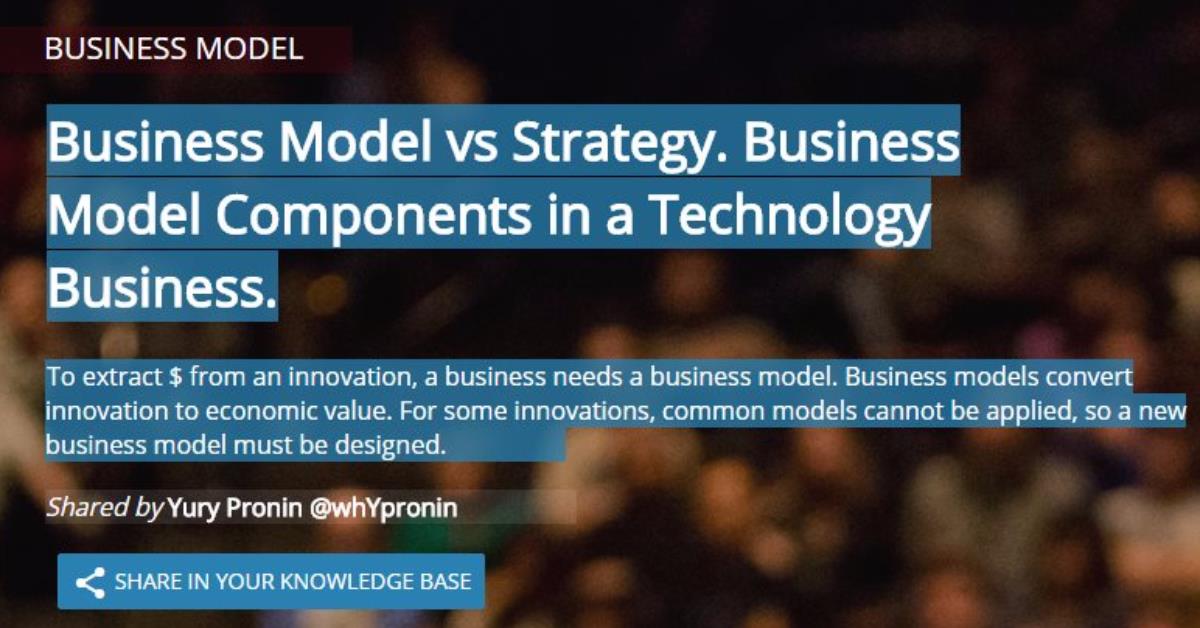| John Burson edited Tuesday, May 2, 2017 |
Follow |
Business Model vs Strategy. Business Model Components in a Technology Business.
To extract $ from an innovation, a business needs a business model. Business models convert innovation to economic value. For some innovations, common models cannot be applied, so a new business model must be designed.AD
Get access to EB 5 Visa Approved Projects.
- Add your EB5 Project
- All Points North, a Targeted Employment Area- Expedite your EB-5 Visa Journey

- Copper Valley Rural TEA EB5 Project

All USCIS Approved EB5 Projects
Categories
To extract $ from an innovation, a business needs a business model. Business models convert innovation to economic value. For some innovations, common models cannot be applied, so a new business model must be designed.
Note: It happens that innovation lean not on the product but on the business model itself.
The role of the business model in innovation business
Henry Chesbrough and Richard S. Rosenbloom show in a paper, "The Role of the Business Model in Capturing Value from Innovation", a framework of a business model. In the complexities of products, the environment business operates, few individuals fully understand the business's tasks in their fullness. The technical experts and the business experts know own domains. The business model connects two domains:| Technical Inputs | | Business Model | | Economic Outputs |
fig#1. The role of the Business Model in technology business
A business model engages business subjects:
- marketing,
- economics,
- finance,
- operations,
- entrepreneurship
- strategy.
Business model components
Chesbrough, Rosenbloom searched academic and the biz literature and identified components of a business model:
- Value proposition as a description of target customer problem, the product description that addresses the problem, and the value of the product from the customer's perspective.
- Market segment is the group of customers to target, different market segments have different needs. Note: It happens - the potential of an innovation is unlocked when a different market segment is targeted.
- Revenue and margins shows:
- how revenue is generated (ex: leasing, sales, subscription, support, etc.);
- cost structure;
- profit margins.
- Value chain structure shows: the business's position and activities in the value chain and how the business will capture part of the value that it creates in the chain.
- Position in value network shows:
- competitors;
- complementors;
- network effects that can be utilized to deliver more value to the customer.
- Competitive strategy shows how the business will develop a competitive advantage by means of:
- cost;
- differentiation;
- niche strategy.
Business model vs strategy
By Chesbrough, Rosenbloom:| Business Model | Business Strategy |
| Creating vs. Capturing value | |
| Focus on value creation, addresses how that value will be captured by the business. | Goes further by focusing on building a sustainable competitive advantage. |
| Business vs. Shareholder value | |
| Converting innovation to economic value for the business, not delivering value to the shareholder. | Focus on delivering value to the shareholder. |
| Knowledge level | |
| Limited environmental knowledge. | Depends on a complex analysis, requires the knowledge of the environment. |
fig #2. tags: Business model vs strategy comparison, business model vs. business strategy
Case: Xerox and new business model
Xerox Corporation's was in the copy machine business with a Model 914.
The Model 914 used new electrophotography process, dry that avoids the use of wet chemicals. In seeking potential marketing partners, Xerox was turned down by IBM, Kodak, GE who had concluded that there was no future in the technology as seen through the lens of the then-prevalent business model. The technology was excellent, the cost of the machine was seven times more expensive than alternatives. The model of selling the equipment below cost and making up by large margins in supplies was not healthy because the cost of the supplies was the same as that of the alternatives.
Xerox decided to market the new product itself. The new biz model was to lease an equipment at low cost and then charge a fee/copy if a customer makes more than 2,000/month. The average copier printed 15-20 copies per day. For Model 914 to be profitable, the use of copies had to increase.
Start-up business model and how it is different
Chesbrough, Rosenbloom summarized that best start-up business model should build a momentum and the business integrates into a model.Start-up has an advantage because it is free:
- to choose,
- to develop a new business model.
VCs see themselves as investing in a business model. VC will push for a change business model when an original model is not working good enough (start-up's spin-off).

Free Consultation
